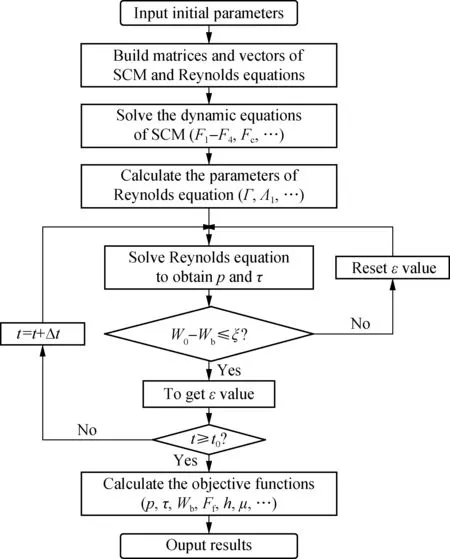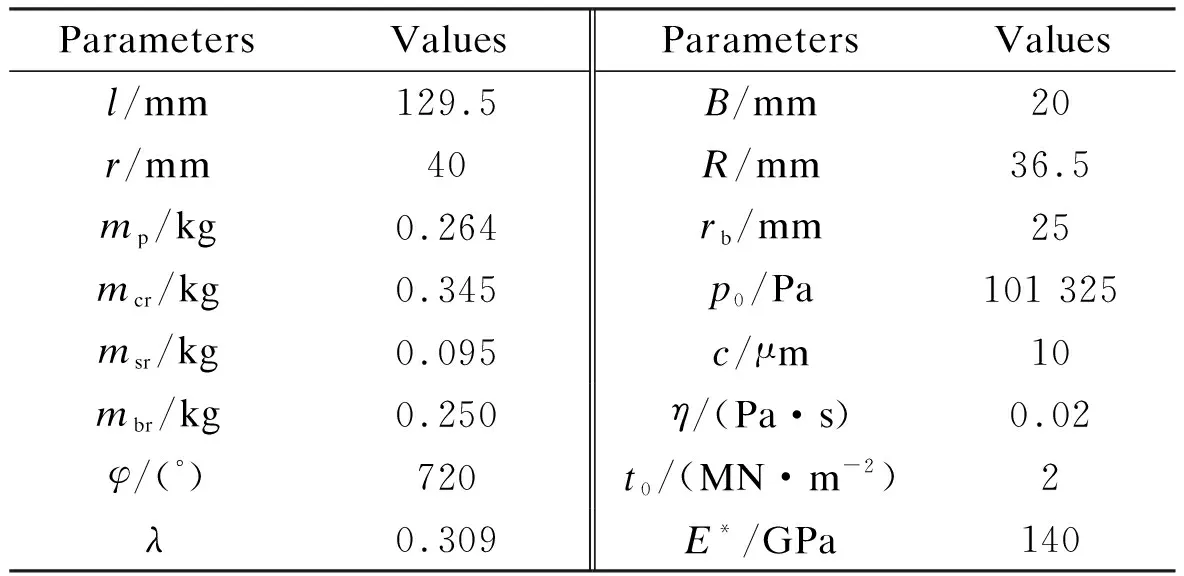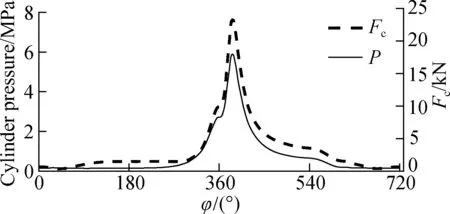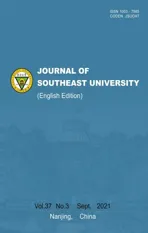Influence of micro asperity contact and radial clearance on the tribological properties of crankpin bearings
2021-10-21NguyenVanLiemZhangJianrunHuangDacheng
Nguyen Van Liem Zhang Jianrun Huang Dacheng
(1School of Mechanical Engineering, Southeast University, Nanjing 211189, China)(2School of Mechanical and Electrical Engineering, Hubei Polytechnic University, Huangshi 435003, China)(3Key Laboratory of Intelligent Conveying Technology and Device, Hubei Polytechnic University, Huangshi 435003, China)
Abstract:A new hybrid numerical method that couples the dynamic slider-crank mechanism (SCM) and crankpin bearing (CB) lubrication models is proposed to analyze the effect of micro asperity contact on the tribological properties of a CB. In the hybrid model, the dynamic equations of the SCM are established based on the Newton method, while the lubrication equations of the CB are established on the basis of the Reynolds equation. Experimental data of the engine are also used in simulation analyses to enhance the reliability of the results. The load-bearing capacity (LBC) and friction force of the CB are selected as objective functions. Results show that the LBC has a negligible effect on the tribological properties of the CB, but the friction force greatly affects the resistance of the bearing under different radial clearances and surface roughness values. In particular, the maximum friction force in the asperity contact region accounts for 40.5% of the maximum total friction force at a radial clearance of 5 μm and 77.7% of the maximum total friction of the CB with a surface roughness of 10 μm.
Key words:crankpin bearing; tribological property; slider-crank mechanism; asperity contact
Improving power and reducing friction loss are key concerns in the design and research of internal combustion engines. Therefore, research on the friction and lubrication performance of bearings is essential to optimize the design parameters of engines.
A large number of studies have been conducted over the last few decades to assess the influence of various piston design parameters on the performance of combustion engines. For example, the inertial force of the piston and the eccentricity between the crankshaft and cylinder center have been investigated to reduce the horizontal impact force of the piston on the cylinder bore and engine balance[1-3]. The influence of the friction force generated by the piston skirt and ring against the cylinder bore during movement, as well as that of the relative motion of the joints of the slider-crank mechanism (SCM) on the engine power, has also been analyzed[4-6]. The results obtained show that the friction power loss caused by relative motion between the friction pairs is not negligible. Research on methods to improve lubrication between the piston and cylinder[2, 6-7]and simulation of the lubrication models of crankshaft bearings[4, 8]to reduce the friction power loss in the SCM has been performed. The results of these works reveal that friction power losses are significantly reduced by increasing the oil film thickness and become stable on lubricated surfaces.
The lubrication condition of journal bearings often belongs to the mixed-or starved-lubrication regime when the sliding pairs are at the start/end verge or in an overloaded state[9-10]. In this case, the micro asperity contact in the mixed-lubrication regime of the journal bearing would increase the friction and wear at the contact region between the shaft and bearing surfaces[11-12]. Thus, investigating the effect of the surface roughness of the journal bearings on the lubrication performance of a bearing under both hydrodynamic and mixed lubrication conditions is necessary.
Previous research[7, 13]suggested that micro asperity contact with a rough surface exerts a great influence on the lubrication performance of journal bearings. Although some scholars have investigated the effects of the pressure[9-10]and shear stress[7, 14]of the asperity contact on the load-bearing capacity (LBC) and friction force of journal bearings, the effects of the LBC and friction force on the tribological properties of journal bearings in the mixed-lubrication regime have not yet been clarified. Moreover, the aforementioned studies mainly considered the effect of static load and usually ignored the external load acting on the journal bearings[10, 15]. The asperity contact load is known to be directly correlated with the wear profile of the bearing bore and the load carried by surface asperities. During the working cycle of an engine, the dynamic load acting on the crankpin bearing (CB) may rapidly change in terms of direction and intensity under changing speeds[4-5]. These phenomena, to some extent, may aggravate the influence of the micro asperity contact in the mixed-lubrication regime on the tribological properties of the CB and increase the power loss of the engine.
The current paper presents a new numerical simulation method that combines the dynamic SCM and CB lubrication models to evaluate the tribological properties of a CB comprehensively. In contrast to previous studies that only considered LBC and the friction force of the oil film on the tribological properties of the CB, this work completely analyzes the influence of the micro asperity contact and radial clearance on these properties. A program written in MATLAB is then applied to solve the corresponding dynamic and lubrication equations. Various radial clearances and surface roughness values are considered in the mixed-lubrication regime to explain their influence on the tribological properties of CBs.
1 Method
1.1 Dynamic slider-crank-mechanism model
The dynamic force of the SCM model is calculated by assuming that the center of the crankshaft coincides with the cylinder center, as shown in Fig.1.

Fig.1 SCM model with lubricated joints
According to the SCM model and its dynamic motion principle, the piston’s acceleration in thez-direction can be determined by[7, 15]
(1)
whereλ=r/l;randωare the rotational radius and angular velocity of the crankshaft, respectively; andlis the connecting rod length.
Assuming that the mass of the connecting rod is the sum of the masses of the large-rod end (mbr) ato1and the small-rod end (msr) ato2, the inertial force of the total mass of the piston (mp) and the small-rod end is determined by
(2)
When a combustion gas pressure is exerted on the piston peak (P=pgπR2), the forces acting on the connecting rod, cylinder wall, and crankshaft can be expressed as follows:
(3)
The total mass of the large-rod end of the connecting rod is rotated with an angular velocity of the crankshaft, and the centrifugal inertial force on the rod is written as follows:
Fic=-mbrrω2
(4)
The bearing of the connecting rod provides the crankpin with a rotating motion within the rod. Thus, the total force acting on the CB is
(5)
Changes in forceFcin terms of direction and intensity are then used as the dynamic load to analyze the tribological properties of the CB.
1.2 Crankpin bearing lubrication model
The CB is impacted by the dynamic forceFcand rotated with the same angular velocityωof the crankshaft. A journal bearing consisting of the shaft imposed by the external dynamic loadW0=Fcand rotating inside the bearing with the angular velocityωis modeled to analyze the tribological properties of the CB; the Cartesian counterpart of this model is also constructed[16], as plotted in Fig.2(a). The surface roughness of the shaft and bearing, which has a great influence on the impact force between the shaft and bearing[11], and the lubrication performance of the journal bearings[10, 15]are further considered in this model, as shown in Fig.2(b).
In Figs.2(a) and (b),rbandrsrefer to the bearing and shaft radius (rb>rs), respectively, and the small gap between the bearing and shaft is filled with lubricating oil to generate hydrodynamic pressure. Moreover,eis the eccentricity between the center of the shaft and the bearing;u0=ωrbrefers to the relative sliding velocity between the shaft and bearing surfaces;ψandφare the attitude angle and angular coordinate, respectively,Bis the bearing width; andhandpare the oil film thickness and pressure, respectively. Herehis determined by the relative position between the shaft and bearing and could be expressed as follows[10, 12]:
h=rb-rs+ecosφ=c(1+εcosφ)
(6)
wherec=rb-rsandε=e/care the radial clearance and eccentricity ratio between shaft and bearing (0<ε<1),respectively.
According to the model in Fig.2(a), the bearing surface is fixed in thex-andy-directions, while the shaft surface only moves in thex-direction under some velocityu0. Thus, the velocity boundary conditions on the CB surfaces can be expressed as
(7)
The lubrication equation of the CB can be conveniently solved by assuming that the influence of the inertia of the lubricant flow is negligible, that the lubricant density and viscosity are constant in the working process, and that the fluid velocity in thez-direction is equal to zero. In practical conditions, however, the CB surfaces are randomly oriented, as shown in Fig.2(b). Thus, the pressure-flow factors ofφxandφyreflect the resistance of the surface roughness to the lubricant flow[15], and the shear flow factorφsof the additional flow attributed to these two factors[13]may be employed to determine the expected volumetric flow.
According to the fluid continuity condition, the Reynolds equation of the expected volumetric flow is determined by[15, 17]
(8)
whereσis the variance of the composite surface roughness of the CB andηis the dynamic viscosity of the oil.
The dimensionless form of Eq.(8) is expressed as

(9)
whereφ=x/rb,Y=y/B,H=h/c,P=p/p0,T=t/t0,u0=ωrb,Λ1=6ηωB2/(p0c2),Λ2=12ηB2/(t0p0c2),β=B/rb,Γ=σ/c, andp0=101 325 Pa is the standard atmospheric pressure.
Eq.(9) can be solved by determining the boundary conditions of the oil film pressure. Assuming that an oil film thickness is distributed on the CB, the inlet/outlet of the lubricant is located at the point at which the maximum film thickness corresponds toφ=0° and 360°. The atmospheric pressurep0is the ambient pressure around the CB and the inlet/outlet pressure for the computational domain. Thus, the pressure boundary conditions are defined by
(10)
1.3 Mixed hydrodynamic lubrication forces
1.3.1 Load bearing capacity
Under the effect ofW0, the LBC generated by the oil film pressure is expressed as[18]
(11)
In addition, in the mixed-lubrication regime of the contact between the shaft and the bearing surfaces, the asperity contact pressurepacgreatly influences the LBC when the ratio of the oil film thicknessh/σ<4[12]. Assuming that the surface roughness obeys a Gaussian distribution,paccan be calculated according to the asperity contact model of Greenwood and Tripp as follows[9]:
(12)
whereE*is the composite elastic modulus;ζis the asperity radius of curvature; andF5/2(4-h/σ) is the probability of the asperity height of the surface roughness.
Thus, the LBC generated by thepaccan be expressed as
(13)
Based on the LBC of theWofandWac, the actual LBC of the CB is then determined as follows:
(14)
whereWbis equal to the external dynamic load acting on the CB, as written in Eq.(5).
1.3.2 Friction force and friction coefficient
Under the effect of interfacial shear and asperity contact in the mixed-lubrication regime, the interfacial shear stressτisand asperity contact stressτacare given by[12, 17]
(15)
whereτ1andτ2are the inter-fluid shear stress and shear stress of the fluid acting on bumpy peaks, respectively;τ0andμ0are the shear stress and boundary friction coefficients, respectively.
The total friction force is then defined by
Ff=Fis+Fac=∬τisdxdy+∬τacdxdy
(16)
whereFisandFacare the friction forces of the oil film and asperity contact, respectively.
AfterFfandWbare determined, the friction coefficientμof the CB can be calculated by[18]
(17)
The parameters ofWb,Ff, andμwere selected as evaluation indices to analyze the tribological properties of the CB in this study[12, 18]. Two other parameters, namely,WacandFac, were also selected to analyze the influence of the asperity contact on the tribological properties of the CB in the mixed-lubrication regime. Thus, increases in LBC and reductions in the frictional force of the CB could be described by objective functions. The computational scheme for the objective functions is conducted in MATLAB, as shown in Fig.3.
2 Results and Discussion
The parameters listed in Tab.1 and the external forceFc=W0obtained at a crankshaft speed of 2 000 r/min, as indicated in Fig.4,[4, 15]are applied to highlight the effect of the asperity contact in the mixed-lubrication regime on the tribological properties of the CB. The effects of various radial clearances and surface roughness values on the tribological properties of the CB are then investigated.

Fig.3 Computational flowchart

Tab.1 Simulation parameters

Fig.4 Dynamic force of the SCM
2.1 Effect of radial clearance
The effects of different radial clearances of (c=5, 10, 15, 20, 25 μm) between the shaft and bearing are simulated, and the distribution results of the oil film pressure and shear stress on the CB surface atc=10 μm are shown in Fig.5. The results indicate that the highest pressures of the oil film are mainly distributed from 90° to 180° of the circumferential coordinates, and the maximum pressure of the oil film (88.8 MPa) occurs at 158° when the bearing width isB/2. The shear stress is uniformly distributed along the bearing width but changes remarkably over the circumferential coordinates evaluated and peaks at 178°.
The oil film pressure and shear stress distributions obtained at a bearing width ofB/2 under various radial clearances are illustrated in Fig.6. Fig.6(a) shows that the oil film pressure is greatly increased by increasingc. Conversely, the oil film shear stress increases whencis reduced because the micro asperity contact between the bearing and shaft surfaces in the mixed-lubrication regime increases, which, in turn, increases the friction force. The simulation results of the tribological properties are shown in Fig.7 to clarify the effect of the various radial clearances on the tribological properties of the CB. The results in Figs.7(a) and (b) indicate that the maximum total loadWbincreases whereas the total friction forceFfmarkedly decreases with increasingc, especially atc=25 μm. The tribological properties of the CB are thus improved.
The above results indicate that assessing the effect of the micro asperity contact on the tribological properties of the CB under various radial clearances may be challenging. Thus, the effect of the asperity contact region is highlighted by plotting the results of the LBC and friction force of the asperity contact, as shown in Figs.7(c) and (d). The results indicate that theWacandFacof the micro asperity contact increase when c is reduced, especially atc=5 μm. However,Wacis very small in comparison withWbunder the various radial clearances evaluated. Therefore, the LBC of the CB is mainly supported by the oil film, and the radial clearance does not remarkably affect the LBC of the CB. Conversely, as shown in Fig.7(d), the friction force tends to increase with decreasingcand vice versa. In particular, the maximumFacaccounts for 40.5% and 31.8% of the maximumFfatc=5 μm andc=10 μm, respectively. Therefore, in addition to the friction forceFisof the oil film, theFacof the asperity contact greatly affects the resistance of the CB.
Under the influence ofFac, the total friction force ofFfincreases remarkably under the various radial clearances. As indicated in Fig.7(e), the friction coefficient also increases, particularly atc=5 μm. Moreover, as the radial clearance decreases, the eccentricity ratioεbetween the shaft and the bearing change minimally, as shown in Fig.7(f), which improves the stability of the bearing. Although reducing the radial clearance can decrease the eccentricity, an increase in the probability of solid contact will result in a significant increase in friction in the asperity contact region of the CB. In other words, a larger radial clearance can effectively reduce friction. However, an excessively large radial clearance can cause the eccentricity ratio between the shaft and bearing to fluctuate greatly, causing the collision between the shaft and bearing. As the radial clearance gradually increases, the reduction in the friction coefficient becomes very limited. Thus, according to the simulation and analysis results, the optimal radial clearance range providing both anti-friction and anti-impact properties simultaneously is 15 μm≤c≤20 μm.
2.2 Effect of surface roughness
The effect of the surface roughness of the CB (σ=2, 4, 6, 8, and 10 μm) on its tribological properties under the same conditions of a loadW0at 2 000 r/min is also evaluated. The simulation results of the oil film pressure and shear stress distributions at a bearing width ofB/2 are shown in Fig.8. The oil film pressure and shear stress increase with decreasingσand vice versa. Thus, the surface roughnessσcan affect the tribological properties of the CB. This finding is further analyzed by plotting the results of the tribological properties, as shown in Fig.9.
Figs.9(a) and (b) reveal that the maximumWbis unremarkably affected by theσwhile theFfremarkably increases with increasingσ, especially atσ=8 μm andσ= 10 μm. Figs.9(c) and (d) demonstrate the influence of surface roughness on theWacandFacof the asperity contact. The results show thatWacandFacsignificantly increase with increasingσ, which could be explained as follows. As the height of the surface roughness increases, the probability of solid contact in the asperity contact region of the CB surfaces also increases, thereby increasing the pressure and stress of the asperity contact. However,Wacis very small in comparison withWbunder the various surface roughness values tested. Thus, the LBC of the CB depends mostly on the oil film pressure. Conversely, theFacaccounts for a remarkable proportion of the totalFf. In particular, the maximumFacaccounts for 68.3% and 77.7% of the maximumFfatσ=8 μm andσ= 10 μm, respectively. Thus, the resistance of the CB may be concluded to be greatly affected by the friction force of the asperity contact.
An increase in surface roughness remarkably increases the contact probability between the micro-convex peak and the resistance generated between the solids. Thus, the friction coefficient also increases withFf, as shown in Fig.9(e). However, the eccentricity ratio is reduced with increasingσas shown in Fig.9(f). An increase inσcauses thepacin Eq.(12) to increase and thehto decrease. These changes cause a corresponding reduction in the eccentricity ratioεin Eq.(6), which means a more stable oil film thickness and shaft rotation.
The tribological properties of the CB are affected not only by its micro asperity contact and radial clearance but also by its speed and dimension[17]. Moreover, the temperature of the oil film can affect the tribological properties of the bearing; thus, the effect of the temperature and viscosity of the oil film on the lubrication performance of the CB must be investigated further.
3 Conclusions
1) The influences of theWacandFacof the micro asperity contact on the tribological properties of CBs are analyzed[6, 9]. Results show that theWachas a negligible influence on the tribological properties of the CB, while theFacgreatly affects its resistance. In particular, the maximumFacaccounts for 40.5% of the maximumFfatc=5 μm and 77.7% of the maximumFfatσ=10 μm.
2) TheWbsignificantly increases while theFfis reduced with increasing radial clearance of the CB. Thus, the tribological properties of the CB are significantly improved. However, an excessively large radial clearance can cause the eccentricity ratio between the shaft and bearing to fluctuate, thereby causing a collision between the shaft and bearing. The results reveal that the optimal radial clearance range providing anti-friction and anti-impact properties simultaneously is 15 μm≤c≤20 μm.
3)Ffis strongly decreased, whereasWbis unremarkably affected when the surface roughness of the CB is reduced. These effects improve the tribological properties of the CB.
4) The numerical simulation method proposed in this study can not only analyze the tribological properties of the dynamic bearing but also correct the design of bearings and optimize design parameters to enhance the tribological properties of CBs.
杂志排行
Journal of Southeast University(English Edition)的其它文章
- Drivers’ fixation transfer characteristics in urban tunnels
- Performance analysis of a novel tobacco-curing system with a solar-assisted heat pump
- Crossed products for Hopf group-algebras
- Sustainability of health information exchange platform based on information cooperation
- Comparative study of low NOx combustion optimization of a coal-fired utility boiler based on OBLPSO and GOBLPSO
- Concept and evaluation method of equipment system of systems contribution rate
